The orchestration of mammalian tissue morphogenesis through a series of coherent feed-forward loops
- PMID: 21998302
- PMCID: PMC3234836
- DOI: 10.1074/jbc.M111.264580
The orchestration of mammalian tissue morphogenesis through a series of coherent feed-forward loops
Abstract
Tissue morphogenesis requires intricate temporal and spatial control of gene expression that is executed through specific gene regulatory networks (GRNs). GRNs are comprised from individual subcircuits of different levels of complexity. An important question is to elucidate the mutual relationship between those genes encoding DNA-binding factors that trigger the subcircuit with those that play major "later" roles during terminal differentiation via expression of specific genes that constitute the phenotype of individual tissues. The ocular lens is a classical model system to study tissue morphogenesis. Pax6 is essential for both lens placode formation and subsequent stages of lens morphogenesis, whereas c-Maf controls terminal differentiation of lens fibers, including regulation of crystallins, key lens structural proteins required for its transparency and refraction. Here, we show that Pax6 directly regulates c-Maf expression during lens development. A 1.3-kb c-Maf promoter with a 1.6-kb upstream enhancer (CR1) recapitulated the endogenous c-Maf expression pattern in lens and retinal pigmented epithelium. ChIP assays revealed binding of Pax6 and c-Maf to multiple regions of the c-Maf locus in lens chromatin. To predict functional Pax6-binding sites, nine novel variants of Pax6 DNA-binding motifs were identified and characterized. Two of these motifs predicted a pair of Pax6-binding sites in the CR1. Mutagenesis of these Pax6-binding sites inactivated transgenic expression in the lens but not in retinal pigmented epithelium. These data establish a novel regulatory role for Pax6 during lens development, link together the Pax6/c-Maf/crystallin regulatory network, and suggest a novel type of GRN subcircuit that controls a major part of embryonic lens development.
Figures
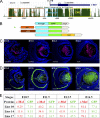
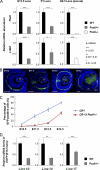


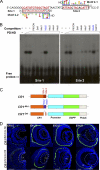
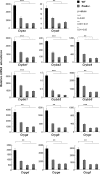
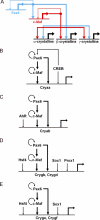
Similar articles
-
Regulation of alphaA-crystallin via Pax6, c-Maf, CREB and a broad domain of lens-specific chromatin.EMBO J. 2006 May 17;25(10):2107-18. doi: 10.1038/sj.emboj.7601114. Epub 2006 May 4. EMBO J. 2006. PMID: 16675956 Free PMC article.
-
Tissue-specific regulation of the mouse alphaA-crystallin gene in lens via recruitment of Pax6 and c-Maf to its promoter.J Mol Biol. 2005 Aug 19;351(3):453-69. doi: 10.1016/j.jmb.2005.05.072. J Mol Biol. 2005. PMID: 16023139 Free PMC article.
-
Identification of pax6-dependent gene regulatory networks in the mouse lens.PLoS One. 2009;4(1):e4159. doi: 10.1371/journal.pone.0004159. Epub 2009 Jan 9. PLoS One. 2009. PMID: 19132093 Free PMC article.
-
Regulation of gene expression by Pax6 in ocular cells: a case of tissue-preferred expression of crystallins in lens.Int J Dev Biol. 2004;48(8-9):829-44. doi: 10.1387/ijdb.041866ac. Int J Dev Biol. 2004. PMID: 15558475 Free PMC article. Review.
-
The cellular and molecular mechanisms of vertebrate lens development.Development. 2014 Dec;141(23):4432-47. doi: 10.1242/dev.107953. Epub 2014 Nov 18. Development. 2014. PMID: 25406393 Free PMC article. Review.
Cited by
-
A developmental gene regulatory network for C. elegans anchor cell invasion.Development. 2020 Jan 2;147(1):dev185850. doi: 10.1242/dev.185850. Development. 2020. PMID: 31806663 Free PMC article.
-
Molecular mechanisms governing differential robustness of development and environmental responses in plants.Ann Bot. 2016 Apr;117(5):795-809. doi: 10.1093/aob/mcv151. Epub 2015 Oct 14. Ann Bot. 2016. PMID: 26473020 Free PMC article. Review.
-
Functional dissection of the paired domain of Pax6 reveals molecular mechanisms of coordinating neurogenesis and proliferation.Development. 2013 Mar;140(5):1123-36. doi: 10.1242/dev.082875. Development. 2013. PMID: 23404109 Free PMC article.
-
Insights into the biochemical and biophysical mechanisms mediating the longevity of the transparent optics of the eye lens.J Biol Chem. 2022 Nov;298(11):102537. doi: 10.1016/j.jbc.2022.102537. Epub 2022 Sep 27. J Biol Chem. 2022. PMID: 36174677 Free PMC article. Review.
-
REGULATOR: a database of metazoan transcription factors and maternal factors for developmental studies.BMC Bioinformatics. 2015 Apr 10;16:114. doi: 10.1186/s12859-015-0552-x. BMC Bioinformatics. 2015. PMID: 25880930 Free PMC article.
References
Publication types
MeSH terms
Substances
Grants and funding
LinkOut - more resources
Full Text Sources
Molecular Biology Databases
Miscellaneous

